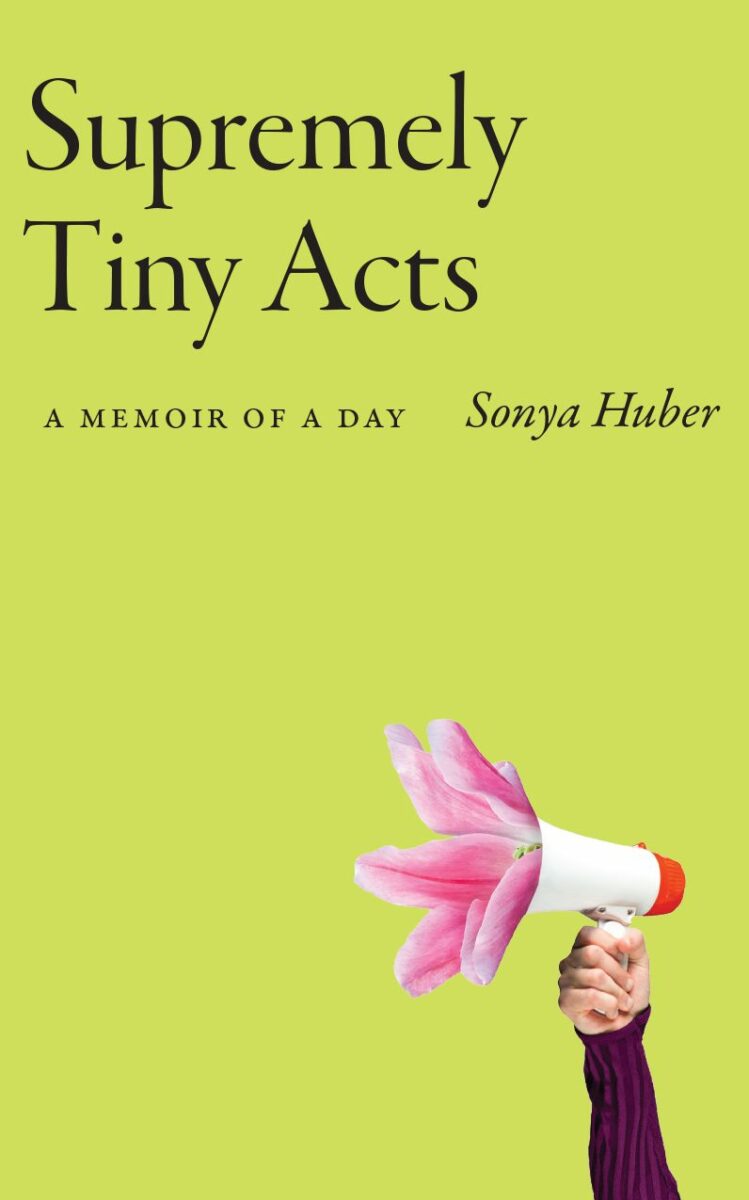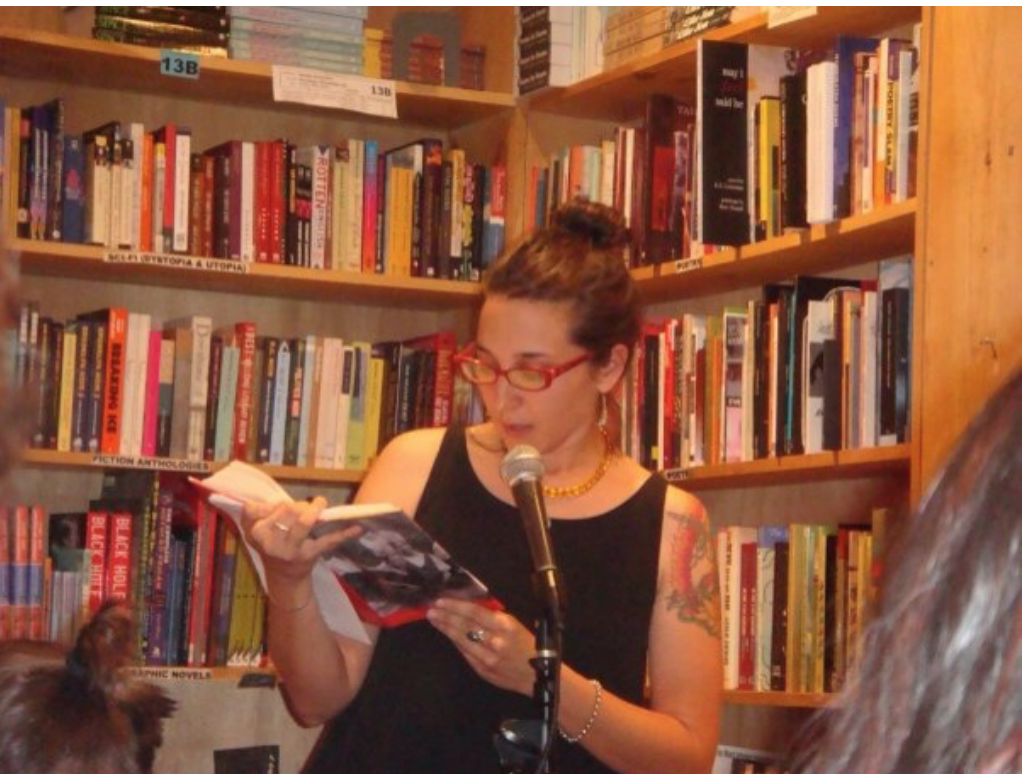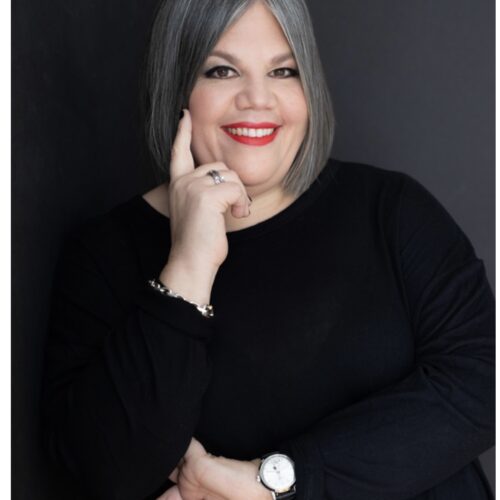Interview by Amy Fish
 About Supremely Tiny Acts: A Memoir of a Day:
About Supremely Tiny Acts: A Memoir of a Day:
“I think we have to get to the real, to catch the facts we have, to hold on to what we see … in this time where lies are currency,” Sonya Huber writes in her book-length essay Supremely Tiny Acts: A Memoir of a Day. On the theory that naming the truths of quotidian experience can counter the dangerous power of lies, she carefully recounts two anxiety-fueled days one fall.
On the first, she is arrested as part of a climate protest in Times Square. On the other, she must make it to her court appearance while also finding time to take her son to get his learner’s permit. Paying equal attention to minor details, passing thoughts, and larger political concerns around activism and parenting in the Trump-era United States, Huber asks: How can one simultaneously be a good mother, a good worker, and a good citizen? As she reflects on the meaning of protest and on whiteness and other forms of privilege within political activism, Huber offers a wry, self-aware, and stirring testament to the everyday as a seedbed for meaningful change. (OhioStatePress)
Amy Fish: Sonya, I am so happy you agreed to this interview. I’ve been in both your Hippocampus workshops (online and at the conference) and I love your work. Where am I catching you right now?
Sonya Huber: I just got done teaching. I’m teaching an Intro to Creative Nonfiction and a literature class on reading and writing place. We read Annie Dillard’s “Pilgrim at Tinker Creek” and Jamaica Kincaid’s “A Small Place.” Both are examples of immersion writing.
AF: Your book takes place all in one day, did you literally write the book in a day?
SH: I actually didn’t know I’d be writing a book till after the court thing. [I thought I’d write] maybe an essay—I had no idea. I had a lot more recorded of my activity than in a regular day because I was journaling—at the end of the day I did a bunch of journaling. I wondered if I could reconstruct the chronology? I made a huge timeline using my social media, my tweets, I looked at which emails I opened. Because I was anxious, I journaled more so I had pretty extensive notes about the action[i] itself and training for the action.
In my first draft, I looked at what I was thinking about at various points in the day. How to reflect and introduce the context of my life outside of that day, where to break for flashbacks.
AF: How did you choose this particular day to write a book about? Were there other days that were contenders?
SH: There were no other days. My days are pretty boring. This day stood out as so different because all days are the same.
AF: What would be the difference in your opinion about writing about a day that actually happened, and using this technique for fiction?
SH: Fiction vs. creative nonfiction? The thing I’m most interested in is Lopate’s idea of catching the mind at work, the current of your thoughts. We’re all neurotic, all kinds of worry and concern and shit going on in our heads. I’m a Buddhist and part of meditation is to watch the thoughts.
I’ve wanted to write something like this since I read “The Mezzanine” by Nicholson Baker which is a fictional example of someone who watches his thoughts.

Sonya Huber
AF: Where did this ‘write the day’ idea come from?
SH: The “What Happened” project by Ander Monson, Essay Daily Editor of Diagram. He might have been inspired by another project, I’m not sure, I have to research. He picked a specific date and everyone who wanted to write an essay had to write about this particular day as it happened. That’s the project that inspired me.
AF: Tell me about your interest in Extinction Rebellion, and what’s your second favourite cause?
(Note: Extinction Rebellion is a global climate change movement that bases their protests on minor acts of civil disobedience called “actions.” Actions might include stopping traffic or creating long chains of humans attached together to bring attention to the state of the planet.)
SH: I’m a supporter of Extinction Rebellion because I just want the planet to stay around. Also labour and racial justice stuff—that’s where I tend to go.
AF: What was the hardest part to write?
SH: I don’t even know if this is a good answer but it was all pretty hard. The most nerve-wracking was when my story overlaps with other people’s. For example, the person I met in jail. I don’t want to expose them. I stepped closer to some stuff in here than I have in the past. I reveal my own difficulties and those of people close to me. I felt (sigh) it was easier in this book—I made some references to different things that were not part of the narrative, the plot.
AF: Was there anything that didn’t make it in?
SH: There was a lot of repetition that I cut out. I worry about being a bad mom every twenty minutes.
AF: Were there any areas where you wanted to go deeper?
SH: Yes. A lot. For example, a family member in jail, difficult relationships. In both cases I could write a whole book on the topic. I could have gone on forever.
AF: What was your path to publication?
SH: This is my sixth book. [I’ve written] three books of creative nonfiction with the University of Nebraska Press. This one is [with] Ohio State Press. I also did a political analysis of Hilary Clinton and a UK textbook. I’ve normally published my nonfiction with Nebraska. Ohio State started pretty recently carving space for innovative work. They have an open submission period, I sent in my manuscript. It might have been four or five months or something.
AF: What input did you have on the title and cover?
SH: I love the cover. It’s so good. I told them I love bright happy colors. My brilliant title was “The Day.” The editor picked the phrase “Supremely Tiny Acts” from the manuscript and used that.
AF: I’m pretty sure this was your first time at HippoCamp (2021)? So, what did you think?
SH: I had such a good time. I am just so impressed with Donna’s attention to every detail and real care for how the whole weekend was put together. The respect among attendees, thoughtfully and joyfully together.

Sonya Huber at a reading
AF: What are you reading now?
SH: I’m reading for a class I’m teaching next semester. Unbowed: A Memoir by Wongari Maathai. She won a Nobel Peace Prize, she’s Kenyan, it’s about environmental stuff in Kenya.
AF: What advice to you have for anyone wanting to try this technique—the technique of writing about one day?
SH: It’s interesting, I’ve been doing free workshops with prompts which both focus on the physical and sensory details and thoughts and then merging the two. That’s what I would recommend people try.
AF: Thank you very much.
Supremely Tiny Acts: A Memoir of a Day is out now with The Ohio State University Press. Find Sonya on Twitter, Facebook, or her website.
[i] “the action” is the term used by the Extinction Rebellion for their live demonstrations against climate change.

Amy Fish
Staff Reviewer & InterviewerAmy Fish is a writer of true stories, some of which are funny. She is the author of “I Wanted Fries with That: How to Ask for What You Want and Get What You Need” (NWL 2019) and “The ART of Complaining Effectively” (Avmor 2015). Amy is currently doing her MFA at Kings’ College in Halifax, Canada. She is the Ombudsperson at Concordia University in Montreal, where she lives with her husband and kids.


